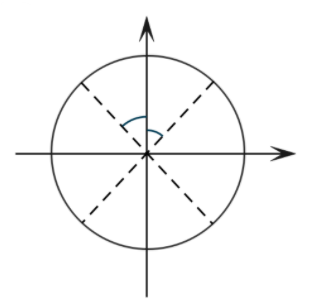
An electric dipole with dipole moment $P = \dfrac{{{p_0}}}{{\sqrt 2 }}(i + j)$ is held fixed at the origin O in the presence of an uniform electric field of magnitude ${E_0}$. If the potential is constant on a circle of radius R centred at the origin as shown in the figure, then the correct statement (s) is/are : (${\varepsilon _0}$ is permittivity of free space. R >>dipole size)

a) the magnitude of the total electric field at any two points of the circle will be the same.
b) total electric field at point A is ${E_A} = \sqrt 2 {E_0}(i + j)$
c) the radius R is $R = {(\dfrac{{{P_0}}}{{4\pi {\varepsilon _0}{E_0}}})^{\dfrac{1}{3}}}$
d) total electric field at point B is zero.

Answer
507.3k+ views
Hint: In the above question, we were told that the radius of the circle is very large than the dipole size. Therefore, we can confirm the circle is equipotential. Next, the net electric field should always be perpendicular to the surface. The electric field at point B along the tangent must be equal to zero.
Complete answer:
Let us write down the given terms and quantities,
$P = \dfrac{{{p_0}}}{{\sqrt 2 }}(i + j)$.
The electric field at point b along the tangent will be equal to zero as the circle is confirmed as equipotential.
Therefore,
$\eqalign{
& {E_0} = \dfrac{{K|P|}}{{{R^3}}},{E_B} = 0 \cr
& \Rightarrow {R^3} = \dfrac{{K{P_0}}}{{{E_0}}} \cr
& \Rightarrow {R^3} = (\dfrac{{{P_0}}}{{4\pi {\varepsilon _0}{E_0}}}) \cr
& \therefore R = {(\dfrac{{{P_0}}}{{4\pi {\varepsilon _0}{E_0}}})^{\dfrac{1}{3}}} \cr} $
It is clear that option c is correct.
The electric field ${E_0}$ is uniform. Due to the presence of dipole, the electric field at different points is different.
Hence, the total electric field will be different at different points. Option a is incorrect.
The electric field at point A ell be,
${E_A} = \dfrac{{2KP}}{{{R^3}}} + \dfrac{{KP}}{{{R^3}}} = 3\dfrac{{KP}}{{{R^3}}}\dfrac{{{P_0}}}{{\sqrt 2 }}(i + j)$
Hence, option b is incorrect.
As discussed earlier, the electric field at point B is zero as the circle is equipotential.
Hence, the correct options are option c and d.
Additional information:
An electric dipole is a pair of equal and opposite point charges -q and q, separated by a distance 2a. The direction from q to -q is said to be the direction of the dipole. The electric dipole moment is a measure of the separation of the positive and negative electric charge within a system, that is, a measure of the system's overall polarity. SI units of the dipole moment are coulomb meter. In atomic physics and chemistry, we use a common unit called Debye.
Note:
The angle involved in the electric dipole is defined with respect to the electric field lines. Most of us assume that the angler involved in the electric dipole is defined with respect to equipotential lines. Dimensional analysis also should be taken care of during the calculations.
Complete answer:
Let us write down the given terms and quantities,
$P = \dfrac{{{p_0}}}{{\sqrt 2 }}(i + j)$.
The electric field at point b along the tangent will be equal to zero as the circle is confirmed as equipotential.
Therefore,
$\eqalign{
& {E_0} = \dfrac{{K|P|}}{{{R^3}}},{E_B} = 0 \cr
& \Rightarrow {R^3} = \dfrac{{K{P_0}}}{{{E_0}}} \cr
& \Rightarrow {R^3} = (\dfrac{{{P_0}}}{{4\pi {\varepsilon _0}{E_0}}}) \cr
& \therefore R = {(\dfrac{{{P_0}}}{{4\pi {\varepsilon _0}{E_0}}})^{\dfrac{1}{3}}} \cr} $
It is clear that option c is correct.
The electric field ${E_0}$ is uniform. Due to the presence of dipole, the electric field at different points is different.
Hence, the total electric field will be different at different points. Option a is incorrect.
The electric field at point A ell be,
${E_A} = \dfrac{{2KP}}{{{R^3}}} + \dfrac{{KP}}{{{R^3}}} = 3\dfrac{{KP}}{{{R^3}}}\dfrac{{{P_0}}}{{\sqrt 2 }}(i + j)$
Hence, option b is incorrect.
As discussed earlier, the electric field at point B is zero as the circle is equipotential.
Hence, the correct options are option c and d.
Additional information:
An electric dipole is a pair of equal and opposite point charges -q and q, separated by a distance 2a. The direction from q to -q is said to be the direction of the dipole. The electric dipole moment is a measure of the separation of the positive and negative electric charge within a system, that is, a measure of the system's overall polarity. SI units of the dipole moment are coulomb meter. In atomic physics and chemistry, we use a common unit called Debye.
Note:
The angle involved in the electric dipole is defined with respect to the electric field lines. Most of us assume that the angler involved in the electric dipole is defined with respect to equipotential lines. Dimensional analysis also should be taken care of during the calculations.
Recently Updated Pages
NCERT Solutions For Class 9 Hindi Sanchayan - Hammid Khan

NCERT Solutions For Class 6 Maths The Other Side Of Zero Exercise 10.2

Class 1 English Grammar Pronouns Worksheet PDF – Free Download

Class 1 Reading Comprehension Sentences Worksheet PDF

Area of Rectangle Worksheet for Class 3 Maths | Free PDF

Class 5 Long Division Worksheet: 2-Digit Divisors & Remainders

Trending doubts
Which are the Top 10 Largest Countries of the World?

Differentiate between homogeneous and heterogeneous class 12 chemistry CBSE

Why is the cell called the structural and functional class 12 biology CBSE

a Tabulate the differences in the characteristics of class 12 chemistry CBSE

Who discovered the cell and how class 12 biology CBSE

Draw a labelled sketch of the human eye class 12 physics CBSE




